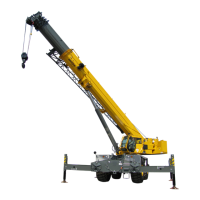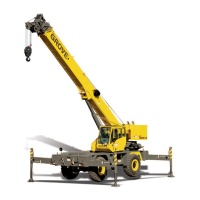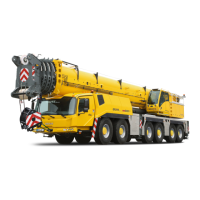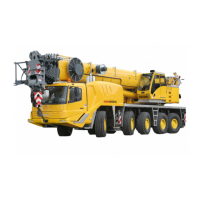SAFETY INFORMATION RT770E OPERATOR MANUAL
2-4 Published 04-04-2017, Control # 446-09
it is important that you have specific training on the particular
crane you will be operating.
Training is ESSENTIAL for proper crane operation. Never
jeopardize your own well-being or that of others by
attempting to operate a crane on which you have not been
trained.
You must be mentally and physically fit to operate a crane.
Never attempt to operate a crane while under the influence
of medication, narcotics, or alcohol. Any type of drug could
impair physical, visual and mental reactions, and
capabilities.
As operator of this crane, you are granted the authority to
stop and refuse to lift loads until safety is assured.
OPERATIONAL AIDS
Operational aids are accessories that provide information to
facilitate operation of a crane or that take control of particular
functions without action of the operator when a limiting
condition is sensed, as stated in the latest revision of the
ASME B30.5, and ASME B30.8 standards. Examples of
such devices include, but are not limited to, the following:
anti-two-block device, rated capacity indicator, rated capacity
limiter, boom angle or radius indicator, boom length indicator,
crane level indicator, hoist drum rotation indicator, load
indicator, and wind speed indicator.
Manitowoc remains committed to providing reliable products
that enable users and operators to safely lift and position
loads. Manitowoc has been an industry leader in the
incorporation of operational aids into the design of its cranes.
Federal law requires that cranes be properly maintained and
kept in good working condition. The manuals that Manitowoc
provides that are specific for each crane and the
manufacturer’s manuals for the operational aids shall be
followed. If an operational aid should fail to work properly, the
crane user or owner must assure that repair or recalibration
is accomplished as soon as is reasonably possible. If
immediate repair or recalibration of an operational aid is not
possible and there are exceptional circumstances which
justify continued short-term use of the crane when
operational aids are inoperative or malfunctioning, the
following requirements shall apply for continued use or
shutdown of the crane:
• Steps shall be taken to schedule repairs and
recalibration immediately. The operational aids shall be
put back into service as soon as replacement parts, if
required, are available and the repairs and recalibration
can be carried out. Every reasonable effort must be
made to expedite repairs and recalibration.
• When a Load Indicator, Rated Capacity Indicator, or
Rated Capacity Limiter is inoperative or malfunctioning,
the designated person responsible for supervising the
lifting operations shall establish procedures for
determining load weights and shall ascertain that the
weight of the load does not exceed the crane ratings at
the radius where the load is to be handled.
• When a Boom Angle or Radius Indicator is inoperative
or malfunctioning, the radius or boom angle shall be
determined by measurement.
• When an Anti-Two-Blocking Device, Two-Blocking
Damage Prevention Device or Two-Block Warning
Device is inoperative or malfunctioning, the designated
person responsible for supervising the lifting operations
shall establish procedures, such as assigning an
additional signal person to furnish equivalent protection.
This does not apply when lifting personnel in load-line
supported personnel platforms. Personnel shall not be
lifted when anti-two-block devices are not functioning
properly.
• When a Boom Length Indicator is inoperative or
malfunctioning, the designated person responsible for
supervising the lifting operations shall establish the
boom lengths at which the lift will be made by actual
measurements or marking on the boom.
• When a Level Indicator is inoperative or malfunctioning,
other means shall be used to level the crane.
Rated Capacity Limiter (RCL) Systems (If
Equipped)
Your crane may be equipped with an RCL system which is
intended to aid the operator. An RCL is a device that
automatically monitors radius, load weight, and load rating
and prevents movements of the crane, which would result in
an overload condition.
Test daily for proper operation. Never interfere with the
proper functioning of operational aids or warning devices.
Under no condition should it be relied upon to replace the
use of Load Charts and operating instructions. Sole reliance
upon these electronic aids in place of good operating
practices can cause an accident.
Know the weight of all loads and always check the capacity
of the crane as shown on the Load Chart before making any
lifts.
NEVER exceed the rated capacity shown on the Load Chart.
Always check the Load Chart to ensure the load to be lifted
at the desired radius is within the rated capacity of the crane.
For detailed information concerning the operation and
maintenance of the RCL system installed on the crane, see
the RCL manufacturer’s manual supplied with the crane.
Manufacturers of rated capacity limiters may refer to them in
their manuals as a load moment indicator (LMI), a hydraulic
capacity alert system (HCAS), a safe load indicator (SLI), or
an EKS5; Manitowoc refers to these systems as a rated
capacity limiter (RCL) throughout its Operator and Service
Manuals.
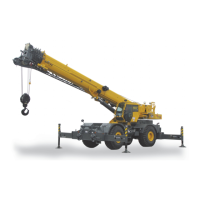
